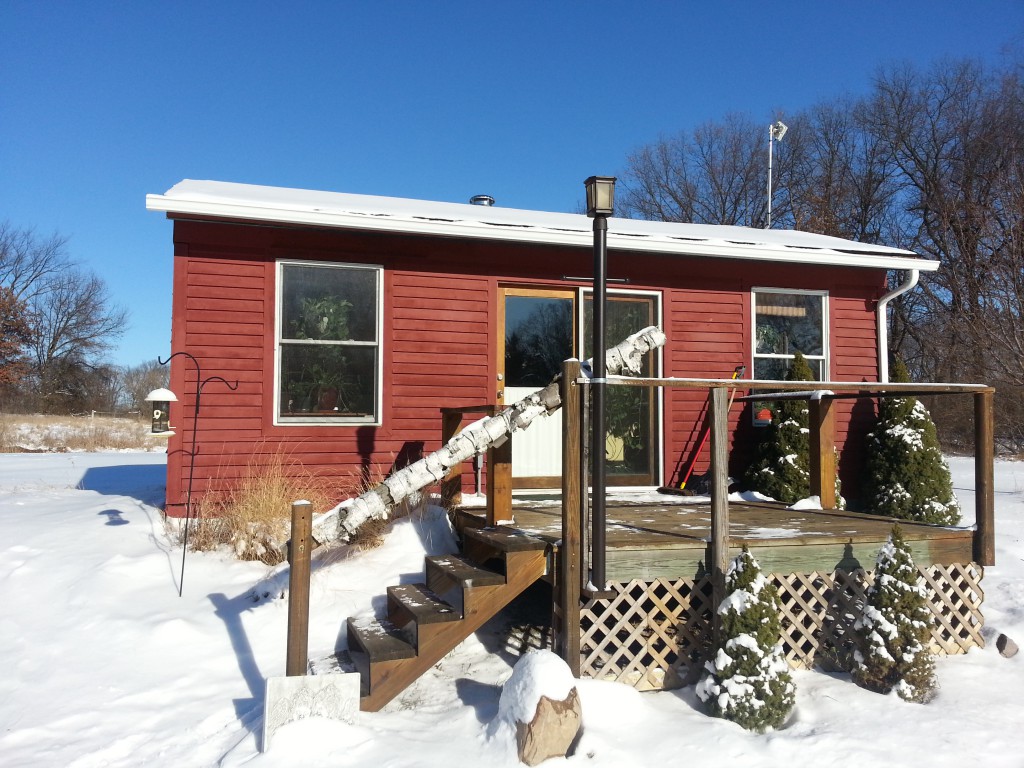Thermal Mass Wood Stove Brick Surround
Description:
A clay brick wood stove surround, designed to operate as a thermal mass heater and safety barrier.
Benefits:
- Allows for safe operation of a wood stove in small spaces. A wood stove can produce high heats and so requires quite a bit of its own protected space. In my 400 sqft home there would not have been enough room to operate a wood stove, without a fire resistant surround.
- Moderates heat output. The thermal mass of the wood stove surround helps create consistent heating. Although it takes some time to heat the clay brick, once it is warmed it radiates a more constant and comfortable warmth than a normal wood stove. A normal wood stove will produce a wider fluctuation in temperatures as the wood burns and then the stove cools.
- Possibly reduces wood consumption. Other authors report needing to feed their wood stove less often after installing a thermal mass surround. This is a convenience as well as a cost saving factor. I could not confirm this benefit, because it would not have been safe to use my wood stove without a surround.
- Feels safer with kids in the home. I was a little concerned about installing a wood stove in my one room home because of my kids. My son loves to use the home as a jungle gym and one inadvertent meeting with the stove could be a disaster. The brick surround gives me peace of mind that the kids are safer.
Background:
The idea for a thermal mass surround came to me after learning about thermal mass rocket stoves. In fact, it was a rocket stove that I first looked into installing in my small home. I decided against one because I could not find someone who could help me install it and who had had success with the technology in a small 3 ft X 3 ft space. I also had a wood stove available for free use. I decided to use the wood stove and optimize its performance using a thermal mass surround.
Design:
After some researching, I found two other people who had the same idea as myself. Both of these people had used cinder blocks for thermal mass. I learned that over time the cinder blocks crack from the heat. I was planning on a more-or-less permanent fixture, and so decided to use clay brick. I chose to use reclaimed, old style clay brick because it has a solid core. I got this idea from a website devoted to building traditional ovens. It mentioned that newer bricks handle heat poorly, but the old clay bricks are durable and much less expensive than firebricks.
After communicating with the guy who designed one thermal mass wood stove, I decided to build my wall 4 inches away from the stove. He had discovered through trial and error that that design performed better than pushing them right up against stove.
Cautions:
One potential disadvantage of this technology is that most wood stoves are specified to have more “breathing room” around them, than the 4 inches of space this surround provides. I found some heating contractors warning that the wood stove could “burn out” early. I, however, could not find a single report of this actually happening. To the contrary, both of the individuals with practical experience with thermal mass surrounds told me their stoves were operating nicely. One had been using the cinder block surround for over 5 years.
Another caution about a project like this, is to consider the need for reinforcing the floor. The weight of the wood stove and brick surround is considerable. This small home was built with 4X6 post and beams and so ultimately no further floor reinforcement was needed.
Last Word:
This was a costly project for me, especially in terms of time and effort. I’m not sure the thermal surround saves enough in wood consumption to offset the cost of the project. That being said, I’m loving the cozy, constant heat produced by this wood stove compared to the noisy, erratic vent-less gas furnace I previously used. That comfort factor alone made this project it worth it to me.



